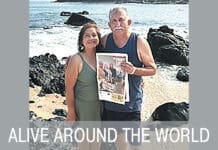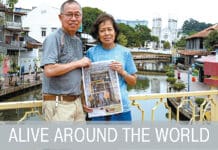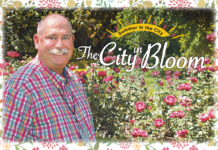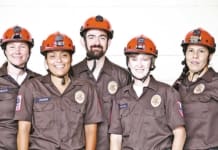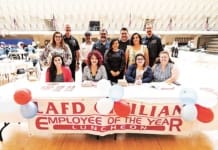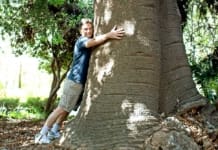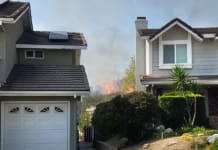 Send in your ALIVE! AROUND THE WORLD
Send in your ALIVE! AROUND THE WORLD
Take Alive! with you wherever you go! Bring your recent copy of Alive! with you when you travel and snap a high resolution photo of you holding Alive! Send in your pictures and text (click on the button to go to the form), and we’ll publish it.
SUBMIT YOUR ALIVE! AROUND THE WORLD
Budapest
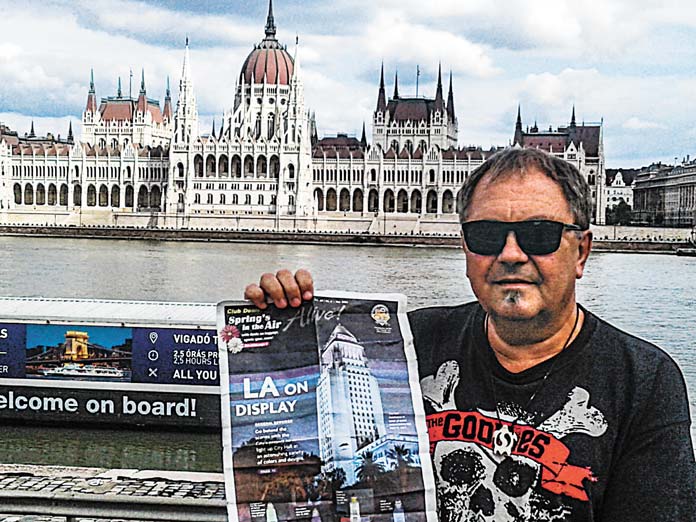
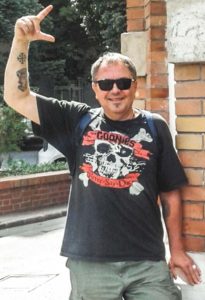
“This photo was just made at the River Danube in Budapest with the uniquely beautiful Hungarian Parliament Building in the background. Greetings to Everyone, Club staff and City fellows.”
Robbie Horvath, Retired, Public Works/Sanitation
Lone Pine, Calif.

“Accomplished climbing Mt, Whitney at 62 years old after being Retired for seven years. Third attempt; first two failed due to altitude sickness. What an accomplishment. Man what a view.”
Vahn Bozoian, Retired, LADWP
Puerto Vallarta Letter, Part 3
Capt. Michael Barnes, Retired, Harbor, traveled to Mexico post-vaccination.

Silver, Spaniards and Raicilla: As we set out to explore a small mining village called San Sebastián del Oeste in the Sierra Madre mountains, we came across Carmen’s panadería and garden, set on the only road into the village over the Progresso Bridge; it’s approximately 65 miles (1 hour, 40-minute drive) northeast from Puerto Vallarta. It is an oasis, providing the perfect place to take a break after the drive. Options for refreshments included an organic coffee along with delicious and freshly baked goods, with gluten-free options available. The garden is interesting and full of tropical plants, a comfortable swing, and clean restroom nearby.
Beside the panadería there’s a great-lookout point, with views toward the Progresso single-span bridge and the Hacienda Don Lalin raicilla distillery on the other side of the canyon.

The raicilla distillery was our next stop. Upon arrival, we were met by the owner, who explained the time-consuming and intricate process of making raicilla. It was taught to him by his grandfather, a successful mezcal maker.
Raicilla, like tequila and mezcal, is made from the agave plant and is roasted like mezcal, not steamed like tequila. He also told us that, unlike tequila, it is made from two varieties of agave—lechuguilla and puta de mula. Raicilla is sweeter with a smoky flavor and is richer in taste than most other mezcals, but he said that it takes 22 pounds of agave to make a quart of raicilla. To obtain the agave needed to make the raicilla, he said that he had to plant the agave by hand in rows amongst all the oak trees at about 1,500 meters of elevation, and wait at least seven years until it matures, at which point he removes the center and bakes it for three days on charcoal made from local oak trees. Once it reaches a molasses-like texture, he smashes the agave like grapes, and then slow-cooks the mash, with the steam passing through copper pipe cone, which is cooled by spring water. The juice goes into wood containers.
We said goodbye after our raicilla lesson and having enjoyed the home brew, and set off on the five-mile drive off the main highway, up a winding, rough and uphill road to visit the organic coffee plantation called La Quinta Café de Altura, just outside of San Sebastián del Oeste.
Because the coffee plantation is set high in the mountains (4,500 feet in a cloud forest), the altitude and climate make it the place to grow coffee beans. La Quinta Café de Altura is a small family-run organic coffee plantation owned by the Sanchez family for generations. As it was not a very busy day, we took a leisurely stroll around the grounds and under the fruit trees, looking at the coffee bushes and checking out their collection of caged noisy colorful blue and green macaws that constantly say “hola!” Watch out as they eat the coffee fruit! Keep your hands out of their cages! We saw the large area where the beans are dried under the sun, and an interesting collection of old coffee manufacturing machinery. Visitors can purchase the local pottery that includes coffee mugs of course, and fresh bags of coffee.

Our next stop was the 400-year-old town of San Sebastian Del Oeste that once served as an outpost and home base for Spanish colonial miners during the early Spanish Vice-Royalty days. Gold, silver and lead were mined in the area from more than 25 mines, and a number of foundries were established by 1785.
San Sebastian del Oeste was formally established as a city in 1812 and all but abandoned by 1921. These days it is a sleepy tourist attraction in the Sierra Madre Mountains with narrow, cobblestone streets ending in the main plaza where visitors will find a large tourist map posted highlighting the local points of interest. There is an ATV rental for daytrippers to take a drive up to La Bufa above the clouds where there are great views of the town below on clear days. But according to our Canadian friend, this could be dangerous, especially if you don’t know the trails, as the mountainside has no guardrails. If it has been raining, the trail in place becomes very dodgy.
We decided to check out the church of San Sebastián Martir and some of the local silver shops. The original Iglesias de San Sebastian Martir was constructed in 1608 by the Franciscan Friars. Though the exterior is not too impressive, it is a different story once you step inside. The interior boasts Corinthian columns and a vaulted ceiling displaying lovely frescos. The church is a true example of Colonial Spanish-style Baroque.
There are many statues and paintings throughout the church, including a model of Jesus in a glass box. Above the main nave are eye-catching crystal chandeliers. The small side chapel has a painting of St. John the Baptist baptizing Jesus, placed behind the baptismal font. There is not an entry fee into the church; however, the small museum next door does charge a small fee.
We continued exploring the narrow streets of San Sebastian and came across an amazing artist who casts his own silver to create beautiful works of art. Both his studio and gallery/shop are in the same building. As you enter you pass by various casting molds for silver projects, using fire opals mined from Mexico’s largest site in Magdalena, Jalisco, along with local silver to create miniature masterpieces, including a pair of earrings we purchased for our daughter. After that stop we continued on to find a statue — specifically a bronze statue of a miner situated in a small plaza. The statue represents the thousands of miners who lived and worked here for hundreds of years.
After seeing the statue, it was time to visit the Los Arcos de Sol, a restaurant in a 200-year-old building where we enjoyed a light lunch and a couple of icy cold adult beverages. The restaurant has a small inside dining area and a comfortable veranda overlooking the cobblestone plaza, with the old church tower just 50 yards away. Many old haciendas in the town and surrounding area are built of cut stone or adobe and have been purchased and restored as hotels, restaurants and private homes. One of the most famous of these haciendas is Hacienda Jalisco, a 20-minute walk outside of town that was once owned by Hollywood artist Bud Acord. It even has an airstrip nearby. Bud Acord was famous for his parties and played host to many actors and directors, including John Huston, Elizabeth Taylor, Richard Burton and Peter O’Toole.
The cobblestone paving has served San Sebastian well, as it never seems to wear out and is easily replaced. Recently the plaza and historical character of San Sebastian is being promoted by the Mexican federal government as a tourism destination, attracting people like us to take a side trip away from Puerto Vallarta.
Tip: If you are going to visit any of these mountain towns, wear sensible shoes, as cobblestones wreak havoc on high heels.





